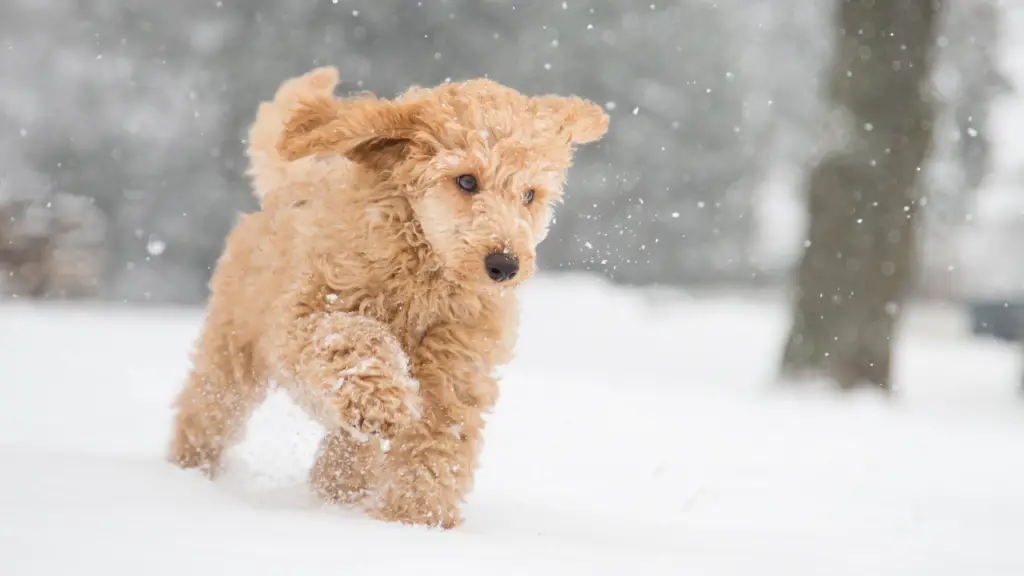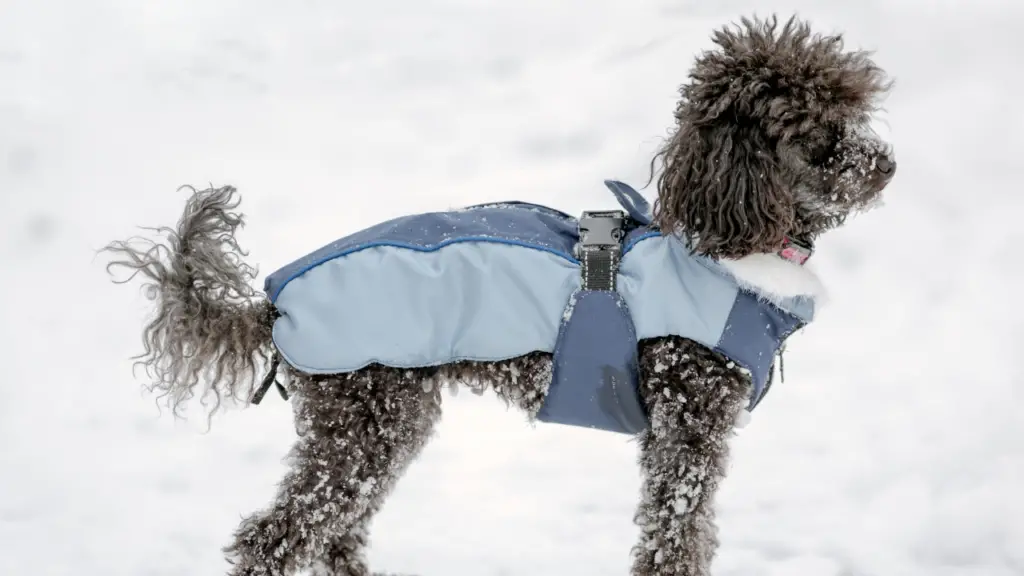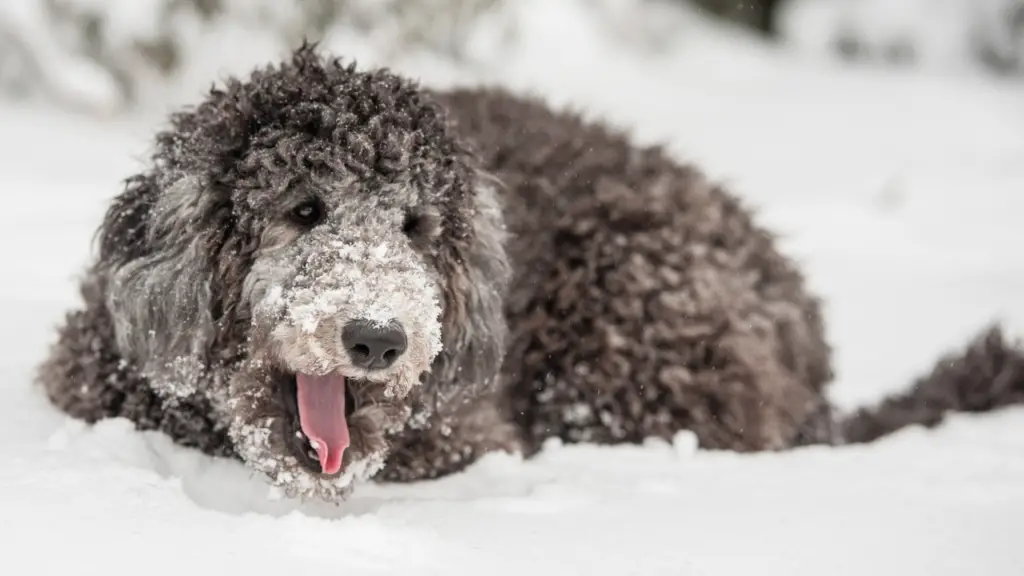Poodles are a popular dog breed known for being easy to train, awesome with kids, and just downright adorable! But can Poodles tolerate cold weather?

Since the winter months are here , it is vital to consider the comfort of your Poodle and its tolerance to cold weather.
In this article, we will break down if Poodles handle cold weather, the temperatures your Poodle can take, risk factors your Poodle may face, signs your Poodle is too cold, and how to take care of your Poodle during colder weather.

Read our Smart Poodles - Smart Tricks eBook for only $2.99
Dive into a treasure trove of engaging tricks and tips designed specifically for your poodle!
Keep reading to find out!
What Will You Learn? 👇
Do Poodles Get Cold Easily?
These dogs usually struggle during the winter months. Poodles handle cold weather for around 10-15 minutes at a stretch at best, before they start getting uncomfortable.
Larger poodles handle cold weather better. Their single-layered coat doesn’t offer much protection against the winter elements, so extended exposure to cold temperatures isn’t recommended for them.

While Poodles can play in the snow briefly, prolonged exposure is not ideal for them. This is due to their single-layer coat, which doesn’t provide much insulation and protection against the outside elements.
Poodle-Specific Features and Risk Factors
Certain features in Poodles make them unable to tolerate cold conditions. Here are some of them.
Single Layer Coat
Despite the thickness and potential length of a Poodle’s coat, it doesn’t provide effective insulation. Single-coated Poodles are susceptible to both hot and cold air as well as wind.
Moreover, when a Poodle’s coat gets wet because of the snow and humid weather, its insulating ability decreases as its coat cannot hold moisture. This is why maintaining a longer coat during cold weather is advisable. Poodle hair is water-resistant unless it’s trimmed very short.
Breed Background
Poodles were not designed to handle cold weather, lacking a historical chance to develop resilience to cold conditions. Poodles resided in mild climates and were originally bred for retrieving waterfowl during hunts.
Over time, Poodles transitioned into beloved indoor family pets, which further emphasizes their lack of adaptation to cold climates.
Standard Poodles Vs. Toy Poodles
Smaller dogs, like Miniature and Toy Poodles, struggle to retain heat compared to larger Poodles like the Standard, who have a larger mass, which helps them retain body heat better.
Due to its compact size and slender build, a Toy Poodle is more prone to hypothermia and frostbite. Being thin exacerbates the risk. Because of this, these Poodles require additional warmth.
Does Age Matter?
Your Poodle’s age affects their coat. A young puppy lacks a full coat, making it more vulnerable to cold weather. Its petite size results in faster body heat loss compared to adult Poodles.
Senior Poodles, being older dogs, may face challenges in regulating their body temperature. This makes it difficult to stay warm and increases the risk of hypothermia and frostbite.
What Temperature Is Too Cold For A Poodle?
For cold-sensitive dog breeds, around 45 degrees Fahrenheit (7 degrees Celsius) is the point where discomfort sets in during longer outdoor stays. If it’s colder, limit your Poodle’s outdoor time and consider a cozy vest for your dog.

In freezing cold temperatures, let your dog out for a short period a few times a day for bathroom breaks. Brisk walks are still important, especially for active Poodles, but consider a vest and maybe paw wax or booties to keep it safe in the cold weather.
(More on how to care for your dog during colder weather in a sec.)
When it’s below 32 degrees Fahrenheit (0 degrees Celsius), even short periods outdoors could lead to frostbite. Paws and ears are most at risk, but any part of the body could be affected.
Frostbite
When a dog is cold, the body prioritizes supplying blood to the torso instead of the paws to conserve warmth for vital organs. This natural response increases survival chances in the wild but puts body parts like paws and ears at a higher risk of frostbite.
Signs of frostbite include:
- Pale or gray skin.
- Coldness in the affected area.
- Pain.
In later stages, a few days after the injury, you may notice:
- Swelling and inflammation in affected areas.
- Ulcers and blisters.
- Areas turning black and blue.
If the affected limb darkens, it could become necrotic, leading to potential limb loss and secondary infections, which can be fatal.
If you suspect your dog has frostbite, seek immediate veterinary attention for antibiotics or other necessary therapies.
Hypothermia
Dogs, including Poodles, usually have a normal temperature between 101.5 degrees Fahrenheit (38.5 degrees Celsius) and 102.5 degrees Fahrenheit (39.2 degrees Celsius). Larger dogs tend to be slightly warmer than smaller ones.

If your dog’s temperature drops to 90-95 degrees Fahrenheit (32-35 degrees Celsius), it indicates mild hypothermia, while temperatures below 84 degrees Fahrenheit (28 degrees Celsius) suggest severe hypothermia.
Common signs of mild to moderate hypothermia include:
- Behavioral changes like nervousness, pacing, refusing to walk, or abnormal movements.
- Holding up a paw.
- Distressed vocalization.
- Pale mucous membranes, especially in the mouth.
- Shivering.
Worsening hypothermia signs include:
- Weakness and lethargy.
- Stiffness in paws and possibly the torso.
- Slow or labored breathing.
- Slow pulse.
If your Poodle seems very cold or shows signs of illness, consider a visit to the vet; once a dog reaches a certain level of hypothermia, medical intervention will be necessary to save its life.
What Temperature Is Too Warm For A Poodle?
As summer approaches, the risk of heatstroke in dogs rises.
Heatstroke occurs when the body overheats and can’t cool itself naturally. Dogs lack sweat glands, so they depend on panting to regulate temperature. Poodles have thinner coats, so they face an increased risk of heatstroke.
Similar to us, dogs can suffer from heatstroke if they don’t drink enough water. Their bodies generate additional warmth in specific areas, causing quicker overheating compared to humans.
Watch for:
- Excessive panting: A sign that your Poodle is trying to cool down by breathing rapidly.
- Elevated temperature: If your Poodle’s temperature surpasses 103 degrees Fahrenheit, it may suffer a heatstroke.
Heatstroke poses a severe threat to your dog, and it can be deadly. Keep an eye out for the symptoms mentioned, and if you suspect overheating, promptly seek a vet’s assistance.
While isolated incidents of overheating can be treated, immediate action is crucial if you suspect heatstroke. If your Poodle is excessively panting or shows a higher temperature, don’t hesitate to take it to the vet.
Prevent overheating by taking extra precautions during warmer months, like limiting activity and providing cool water multiple times a day for your dog.
Biggest Threats To Poodles In Cold Weather
In cold weather, Poodles, like other breeds, can face weather-related issues.
Paw Pads: A Poodle’s paws are sensitive and can freeze if exposed to ice and snow for too long. Frozen pads may split, especially when combined with harmful ice melt chemicals on pavements. It’s crucial to protect your Poodle’s paws with some paw wax or booties.
Nose: While a wet nose is healthy, winter brings challenges. Cold wind quickly dries out the moisture, leading to chapped and cracked noses. If your Poodle licks its nose excessively, the chapping can worsen, becoming a painful issue requiring vet care. You can easily resolve this problem by applying nose balm to your dog’s nose.
Skin and Coat: Dry winter air affects not only us but also your Poodle’s skin and coat. The cold air lacks moisture, leading to excessive scratching, rashes, and raw, dry skin. It’s essential to prevent your Poodle’s skin and coat from drying out during winter with a jacket or sweater and booties.

Signs Your Dog Is Getting Too Cold
Avoiding hypothermia and frostbite in your Poodle is crucial. Watch for signs of your Poodle being too cold, and act promptly.
Look out for:
- Shivering and Trembling: If your Poodle starts shivering, it’s time to go back inside the house. Shivering is an automatic response where your dog’s muscles contract and relax to generate extra warmth.
- Holding Up A Paw: If your Poodle raises a paw, it’s a strong indication of being too cold. Head inside your house immediately. However, if your Poodle is wearing booties, it may not lift a paw, but that doesn’t mean she isn’t cold. Always consider the other signs and act quickly to prevent any emergencies.
- Slow Movements: If your Poodle slows down or refuses to walk, it’s already cold. Head inside your house, and in some extreme cases, you may have to carry your dog back indoors.
- Hunched Back: Just like us, dogs hunch their backs in cold weather. If you notice this, end the walk and go home.
- Tail Between Legs: If your Poodle’s tail is tucked, it indicates discomfort or stress, often a sign of being too cold.
- Unusual Behavioral Changes: Keep an eye out for any behavioral changes like random barking or whining. If things seem off, head indoors promptly. There are many reasons for excessive barking in Poodles, which you can learn more about here.
How To Care For Your Poodle During Cold Weather
To safeguard your Poodle’s vulnerable paws, nose, skin, and coat during cold weather, consider these methods to reduce the risk of hypothermia and frostbite.
Paw Wax Or Winter Boots (Paw Protection)
To shield your Poodle’s paws, you have two options: paw wax or winter boots. Both have their advantages and disadvantages.
Paw Wax
Paw wax is applied before heading out and is more comfortable than winter boots. It forms a protective barrier against snow, ice, and chemical burns. It also helps keep paw pads moisturized.
However, the effectiveness varies, and low-quality waxes might wear off before the walk ends, leaving your dog’s paws exposed.
Winter Boots
Winter boots, or “booties”, are a more durable and reliable option than paw wax. Booties are often waterproof, providing extra protection against snow, ice melt chemicals, and the cold ground, keeping your Poodle warm.
They are equipped with a sturdy rubber sole for grip, which acts as a barrier against salt and grit. While winter boots are pricier than paw wax, many owners find them to be a superior choice.
However, ensuring a proper fit can be a challenge; overly tough material may cause rubbing and chafing on your Poodle’s feet.
Nose Balm Or Butter (Nose Protection)
Protecting your Poodle’s noise from chapping is crucial, and using nose balm or butter is a key preventative measure. If the cold is setting in, consider ordering some promptly.
Prevention is preferred, but certain nose balms also serve as healing creams. If you’re a bit late, nose balm remains a viable option.
They are typically applied once a day, although the frequency may vary if addressing existing issues– refer to the packaging for guidance.
Many dog owners use nose balm year-round for its various benefits. It not only keeps the nose moisturized and shields it from chapping and windburn, but also prevents sunburn in the summer.
Winter Jackets (Skin And Coat Protection)
Winter jackets protect your Poodle against the elements and keep your dog warm. A waterproof jacket is highly recommended for the best shielding.
While a jacket won’t protect the skin of your Poodle from drying out, it significantly enhances warmth during outdoor activities.
Ensure the winter jacket fits properly to stay warm and choose one made of reflective material. Visibility is crucial, especially on gloomy winter days. A jacket made of reflective material will allow you and others to see your dog clearly, especially when walking near roads.
Important Cold Weather Tips and Advice
Ensure your Poodle’s safety in winter with these tips, preventive measures, and general safety advice.
- Clear Snow And Ice From Paws: If your Poodle isn’t wearing booties, make sure to remove snow and ice between its toes physically. This practice helps protect paw pads from freezing and maintains body heat.
- Bathing Routine: Continue bathing your Poodle as usual, but ensure it stays indoors afterward. Use lukewarm water for bathing and shampooing your dog, and dry promptly with a towel or hair dryer (avoid the hottest setting).
Bathing every couple of months with natural ingredients maintains skin and coat health. Stick to lukewarm water to prevent skin drying and avoid extreme hot and cold temperatures.
- Wear An Extra Layer: Consider wearing an additional coat when heading out– not only will it keep you warmer, but it can also serve as a blanket for your Poodle if it suddenly feels too cold. In case your Poodle refuses to walk, you can wrap it in your coat and bring it back to the car.
- Avoid Wet Or Rainy Days: Steer clear of going out on wet or rainy days. Even if the temperature isn’t extremely low, damp conditions can make your Poodle feel colder. To be safe, stay indoors on such days and engage your Poodle in exercises inside your house.
- Practice Exercising At Home: For days when the cold weather is unfavorable, practice exercising indoors. Games like tug of war, fetch, hide and seek, and chasing can effectively keep your Poodle active without getting bored. If you’re uncertain about the cold weather, it’s always a safe option to stay at home!
- Adjust Your Poodle’s Diet: Dogs tend to have a bigger appetite in winter, naturally burning more energy to stay warm. If your Poodle is within a healthy weight range, consider slightly increasing its cup size or supplementing it with additional plain chicken breast during the week.
This boosts overall calories and helps your Poodle gain a bit of healthy weight, which aids in staying warm in cold weather. For a guide on the best dog food for Poodles, check out this article here.
- Avoid Bodies Of Water: Whether frozen or not, stay clear of lakes, rivers, or any bodies of water in your local park during winter walks. It’s a significant safety hazard for both your Poodle and yourself.
- Ensure Good Recall: Practice easy recall training games at home to enhance your Poodle’s recall skills during walks. Immediate recall is crucial, especially in cold weather, and it can even be life-saving. A Poodle that responds promptly is safer in cold temperatures.
- Keep Snow Play Short: While your Poodle may enjoy playing in the snow, keep overall walks short. There’s a delicate balance between having fun and risking getting too cold. Regardless of the fun, limit snow play to 20 minutes or less, ensuring constant movement to prevent heat loss.
FAQs
Do Poodles Fur Keep Them Warm?
Poodles’ fur doesn’t really keep them warm during harsher winter months as they only have a single-layer coat.
Do Poodles Need Winter Clothing To Keep Them Warm?
Because of their single-layer coat, Poodles should be given winter clothing such as jackets, coats, and booties.
What Type Of Climate Is Best For A Poodle?
Poodles do well in moderate climates where the weather isn’t too hot or too cold.
Are Some Poodles More Sensitive To The Cold Weather Than Others?
Smaller poodles, like Toy or Miniature, are more susceptible to heat than Standard Poodles because of their size, which doesn’t retain much warmth.
Marko is the founder and author at PoodleHQ, where he blends profound expertise with formal training in Animal Behavior and Canine Genetics. With multiple generations of poodles under his care, he’s a breed connoisseur, honored with the Canine Care Excellence Award and lauded by the International Pet Enthusiasts Association.

